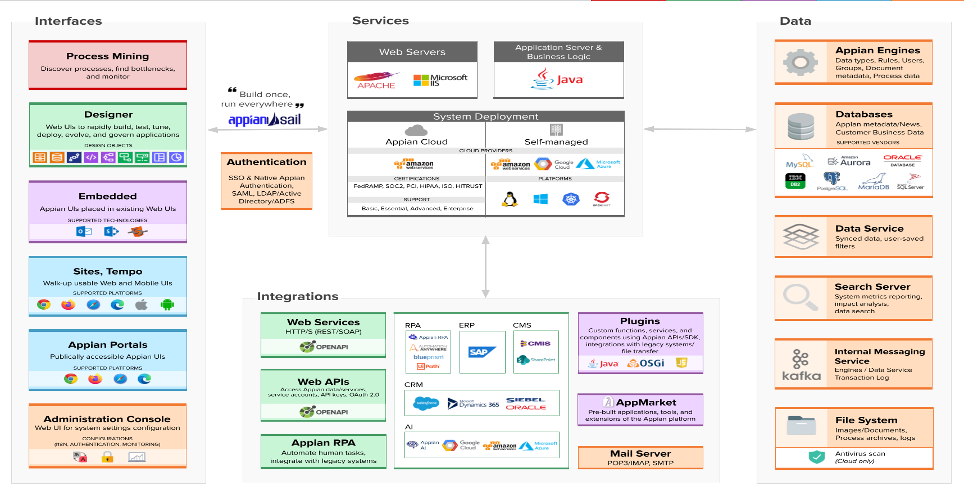Introduction
The digital transformation of businesses has resulted in a growing demand for faster and more efficient ways to develop and deploy software applications. Low-code platforms, such as Appian, have emerged as a solution to this problem, allowing developers to build and deploy applications quickly and easily without writing extensive amounts of code. This technical blog will provide an overview of the low-code platform Appian, its features, and how it can help businesses accelerate their digital transformation.
What is Appian?
Appian is a low-code platform that enables users to build custom applications for their business needs. It includes a visual drag-and-drop interface that allows users to design, build, and deploy applications without writing code. Appian provides a range of features and tools that help developers create applications that automate business processes, manage data, and connect to other systems. It offers a low-code platform with a visual interface and pre-built development modules.
Appian Architecture

This figure is taken from API Documentation 23.1 (https://docs.appian.com/suite/help/23.1/Enterprise_Architecture_Overview).
The Appian platform is built on a multi-tiered architecture consisting of the following layers:
• Interfaces: This layer is responsible for providing a web-based interface for end-users to interact with the application. Appian provides a range of pre-built user interface components that can be used to build custom user interfaces.
• Services: This layer is responsible for processing the user's input and generating the appropriate output. Appian provides a drag-and-drop interface for building business logic using a combination of pre-built and custom components.
• Data: This layer is responsible for managing the application's data. Appian provides a range of features for data management, including data modeling, data integration, and data visualization.
• Integrations: This layer is responsible for integrating the application with other systems. Appian provides a range of integration options, including REST APIs, SOAP web services, and database connectors.
Appian Features
- Drag-and-Drop Interface: Appian's visual interface allows developers to drag and drop pre-built components to build custom applications quickly and easily.
- Workflow Automation: Appian's workflow automation features allow developers to automate business processes, reducing the need for manual intervention and improving efficiency.
- Robotic Process Automation: It connects systems and applications to automate tasks and processes without the need for APIs or custom integrations. Intelligent document processing.
- Digital Process Automation: It automates processes that can span multiple applications. The approach focuses on automating, or partially automating, tasks involved in a variety of business practices that typically require some form of human interaction.
- Business Rules: Appian's business rules engine allows developers to define complex business rules and logic without writing code.
- Data Management: Appian provides a range of features for data management, including data modeling, data integration, and data visualization.
- Collaboration: Appian includes features for collaboration, allowing team members to work together on building and maintaining applications.
- Security: Appian includes features for security, including role-based access control and data encryption, ensuring that applications remain secure and compliant with industry standards.
Appian Benefits
- Speed: Appian's low-code approach allows developers to build and deploy applications quickly, reducing development time and improving time-to-market.
- Efficiency: Appian's workflow automation and business rules engine allows developers to automate business processes, reducing manual intervention and improving efficiency.
- Flexibility: Appian's drag-and-drop interface allows developers to create custom applications that meet their specific business needs, ensuring that the application is tailored to the organization's requirements.
- Collaboration: Appian's collaboration features allow team members to work together on building and maintaining applications, improving teamwork and productivity.
- Security: Appian includes features for security, ensuring that applications remain secure and compliant with industry standards.
Conclusion
Appian is a powerful low-code platform that enables businesses to accelerate their digital transformation by building custom applications quickly and easily. Its visual drag-and-drop interface, workflow automation features, business rules engine, and data management capabilities make it a powerful tool for building applications that automate business processes, manage data, and connect to other systems. Appian's flexibility, collaboration features, and security features make it a popular choice for businesses of all sizes looking to build.
References
• https://docs.appian.com/suite/help/23.1/Enterprise_Architecture_Overview.html• https://www.softwaretestinghelp.com/low-code-development-platforms/
• https://roboyo.global/technologies/business-process-management/what-is-appian/
• https://lowcode.com/articles/low-code-vs--no-code--the-differences--similarities--and-how-to-.html
• https://en.wikipedia.org/wiki/Appian_Corporation